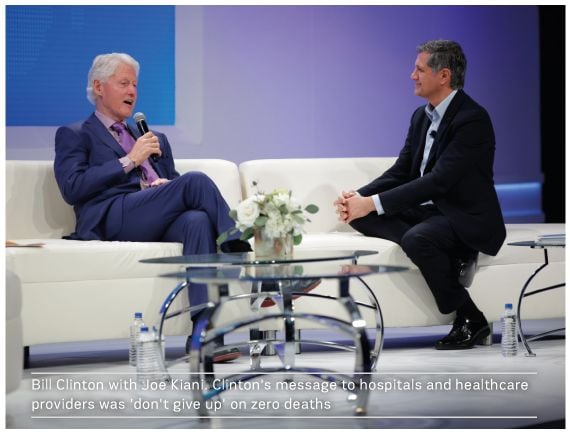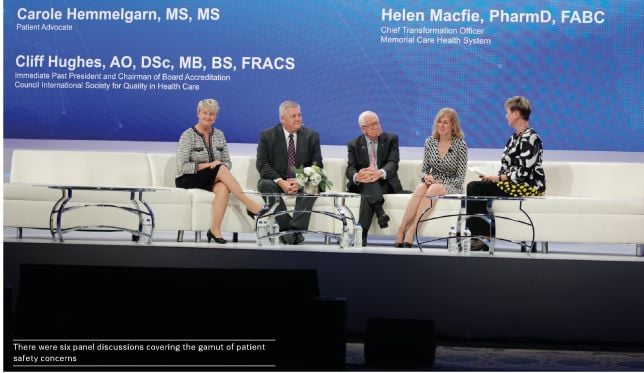I have just returned from the 7th Annual World Patient Safety, Science and Technology Summit. I still remember vividly the impact I felt when I attended my first summit in 2013. I had been in healthcare for over 25 years but, at that time, was fairly new to the arena of patient safety and risk management. When I arrived at the summit, I had preconceived expectations that the event would be similar to the dozens of healthcare conferences I had attended in previous years. What I observed was extraordinary. The summit was unlike anything I had ever experienced at professional conferences.
Each year, the Patient Safety Movement (PSM) creates an atmosphere in which healthcare professionals, patients and patient families can openly and candidly talk about preventable deaths and serious avoidable harm events that occur too often in hospitals across the nation. PSM’s goals include promoting transparency about process and system failures in healthcare that lead to these catastrophic events and providing solutions for eliminating preventable harm and deaths.
What surprises most people is that preventable medical errors are the third-leading cause of death in the U.S. That equates to over 200,000 people a year who enter a hospital to be treated for an ailment or injury that normally wouldn’t prove fatal and end up dying due to an error that could have been prevented if the proper patient safety processes were in place. This statistic doesn’t take into account the thousands more who are inadvertently harmed and survive with physical and emotional challenges they have to live with the rest of their lives.
The power of patient stories
The PSM summits include several panels of healthcare experts and patient advocates discussing a specific patient safety concern. Each panel session starts with a poignant video that tugs at the heartstrings of everyone in the room. In the case of a preventable death, the videos often showcase the tragic loss of life and the impact on the family. In the case of avoidable harm, the videos normally include the actual patient describing the impact the error had on their personal life.
Perhaps the comment most commonly heard from summit attendees is how much they were inspired to action after hearing real-life stories of families who lost a loved one due to a preventable medical error. Patients and their families are intertwined into every aspect of the summit, and they even have a place as panel members to bring the patient’s voice to the center of the conversation.
Listening to the stories and meeting the individuals affected by healthcare failures have had a tremendous impact on my life and the work I do. As a patient safety officer and respiratory therapist, I am always looking for proven ways to make healthcare safer and prevent avoidable harm. My first PSM summit motivated me beyond any medical conference I had ever attended. I returned to my hospital with an extended list of actionable items that I wanted to share with colleagues and implement.
Since that first PSM summit back in 2013, I have attended five summits. I’ve had the opportunity to learn from the best and brightest in the business about their challenges and what is working for them. The experts include healthcare professionals, researchers, scientists, patient safety and risk management specialists, technology industry engineers, and governmental policy makers. The PSM summit recharges my “personal internal batteries” so that I can ensure my hospital is aware of the top patient safety challenges facing hospitals and what best practices can be implemented to address them.
Actionable Patient Safety Solutions (APSS)
The Patient Safety Movement Foundation was started seven years ago to not only bring awareness to the urgent problem surrounding preventable healthcare error-related deaths, but to formulate specific actionable solutions that hospitals can adopt to improve patient safety and prevent the unnecessary deaths of those in their care. Today, there are 18 Healthcare Challenges around which more than 30 Actionable Patient Safety Solutions (APSS) have been developed by teams of medical and patient safety experts. The goal set in 2012 was zero preventable patient deaths by the year 2020 (#0X2020) and requires everyone in the healthcare ecosystem, including hospital administrators, clinicians, nurses, engineers, technologists, patient advocates, and policymakers, to get involved.
This year’s message from the PSM’s Founder and Chairman Joe Kiani was very clear: Only one year remains before 2020, and every hospital needs to adopt and implement APSS in all 18 Challenge categories if we are going to achieve zero preventable deaths. For this to happen, there truly has to be a paradigm shift in patient safety around the world. What used to be acceptable as a Safety I perspective of creating an environment where “as few things as possible go wrong” needs to move to a Safety II perspective that emphasises ensuring “as many things as possible go right.” Zero preventable deaths and harm incidents must be the goal of every hospital. Accepting anything less is not fair to those patients and families trusting us with their lives.
Overview of this year’s event
This year’s summit included presentations from some of the most well-known individuals in healthcare and patient safety from around the world. Reflecting the movement’s accelerating global expansion, this year’s summit was co-convened by the American Society of Anesthesiologists and the European Society of Anesthesiologists. Daniel J. Cole, MD, of the ASA and Kai Zacharowski, MD, of the ESA represented each of their respective organisations with keynote addresses outlining how they have focused on patient safety and preventing harm.
Other recognised experts presenting at the summit included Peter J. Provonost, MD, Chief Clinical Transformation Officer at University Hospitals, David B. Mayer, MD, Executive Director at MedStar Institute for Quality & Safety, and Richard H. Carmona, MD, 17th Surgeon General of the United States (2002-2006).
Joe Kiani kicked off the summit with a moving presentation that outlined the history of the movement and the successes so far. It was incredible to hear about the number of lives saved since the movement began and the number of hospitals that have made a commitment. The efforts and commitments of more than 4,700 hospitals have contributed to an estimated 273,077 lives saved. In addition to those amazing numbers, 89 healthcare technology companies have signed open data pledges that will improve the way medical devices communicate and share information in an effort to create a Patient Data Superhighway, which uses predictive algorithms to catch patient care issues before they become deadly. Joe Kiani’s key message at the summit was that healthcare providers and hospitals around the globe need to move from “hoping for zero to planning for zero preventable deaths.” Everyone in the room could sense Joe’s passion when he stated, “don't let your miracle of healing get hijacked by some medical error that causes your patient's death. We've got to reject the tyranny of apathy and embrace the brilliance of action out of kindness. To err is human but to not put in place processes that can avoid human errors from becoming fatal is inhumane.” He continued to stress the importance of every hospital implementing every APSS.
Panel topics
There were six panel discussions that covered the gamut of patient safety concerns or focus areas of the PSM: a Media Panel discussed how to elevate the coverage of patient safety. A Hospital Leadership Panel examined transparency from a legal perspective. A Healthcare Technology Leadership Panel outlined how data sharing between companies can help to create the aforementioned Patient Data Superhighway. A Transparency and Aligned Incentives Panel had a lively discussion on the effectiveness of transparency and aligned incentives in improving patient safety. A Delirium Panel addressed a preventable condition that is often mistaken as dementia or depression and puts patients at higher risk for a longer hospital stay and death; and lastly, the Leading Causes of In-Hospital Deaths Panel discussed the Safety II approach to making sure everything goes right in patient care. Every panel is on the Patient Safety Movement’s YouTube Channel.
Newly released APSS
Two newly released APSS were announced during the summit. The first one falls under the Medication Safety Challenge and addresses drug shortages in the healthcare system that are caused by such factors as business decisions, manufacturing problems, and product discontinuation. Hospitals can mitigate possible delays in treatment protocol and the increased likelihood of medical errors due to subpar substitutes by reducing preventable shortages of vital medicines.
Dr. Steven Scheinman, Dean of Geisinger Commonwealth School of Medicine, introduced the other new APSS: a Patient Safety Curriculum for Schools. Constituting the 17th healthcare Challenge, this new APSS is a core patient safety curriculum that can be adopted by educational programmes for all healthcare professions (nursing, pharmacy, behavioral health, medicine, etc). It is being released after nearly two years of development by a workgroup comprising academics, clinicians, and patient advocates dedicated to improving patient safety through educating the young. The curriculum will go beyond care of individual patients to address systems of care and close a critical gap in student training when they are introduced to patient safety.
Awards
Five-star hospital ranking
The Patient Safety Movement Foundation recognises medical institutions making the greatest strides in patient safety, honouring them with a Five-Star PSMF hospital ranking. Three hospitals were recognised this year for implementing APSS from all 18 Challenges. They are the Children’s Hospital of Orange County (CHOC), the University of California Irvine (UCI) Medical Center, and Hospital Español in Mexico City.
Humanitarian awards
Each year, the summit also honors the most impactful individuals for their work in improving patient safety across systems of care.
The Steven Moreau Humanitarian Award was presented to William C. Wilson, MD, Chief Medical Officer, UCI Health, for leading UCI Health to a 5-Star Hospital Ranking.
The Beau Biden Humanitarian Award was presented to Julie Morath, RN, MS, President & CEO, Hospital Quality Institute (HQI). Julie has been instrumental in promoting transparency across the entire state of California, encouraging hospitals to voluntarily report on five hospital-acquired conditions through a special public dashboard on their websites.
The PSMF Humanitarian Award was presented to Tore Laerdal, MSc, Chairman & CEO of Laerdal Medical. Under Tore’s leadership, Laerdal has been involved with the PSM since 2017 and is implementing simulation-based training to advance patient safety in over 80+ countries.
Powerful message from former President Bill Clinton
The summit concluded with a keynote presentation by former President Bill Clinton, who recognised the many efforts and successes since Joe Kiani made the commitment to zero by 2020 at the Clinton Global Initiative. President Clinton spoke about the great work the PSM has done so far, with the 273,077 lives saved, the 4,700 hospitals committed to the movement, and 89 technology companies. He reminded the audience that we all signed on to the movement knowing this was going to be a tough road to make a difference, but we are in it for the long haul. President Clinton ended by saying, “My most important message is to please stay active in this, please get more people active in it, and don’t give up.”
Actionable Patient Safety Solutions
Recommended Articles:
For universal healthcare, quality is not the icing, it's the cake




